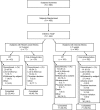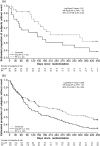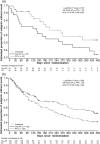Treatment effect with paliperidone palmitate compared with oral antipsychotics in patients with recent-onset versus more chronic schizophrenia and a history of criminal justice system involvement
- PMID: 26403322
- PMCID: PMC5811784
- DOI: 10.1111/eip.12271
Treatment effect with paliperidone palmitate compared with oral antipsychotics in patients with recent-onset versus more chronic schizophrenia and a history of criminal justice system involvement
Abstract
Aim: Long-acting injectable antipsychotics (APs) are not well studied in recent-onset schizophrenia. This exploratory analysis of a study designed to reflect real-world schizophrenia, as defined by patients, interventions and outcomes, compared relative treatment effect between once-monthly paliperidone palmitate (PP) and daily oral APs in patients with recent-onset or chronic illness METHODS: This randomized, open-label, event monitoring board-blinded study compared treatment response in subjects with schizophrenia and a history of criminal justice system involvement following treatment with PP or oral APs for 15 months (ClinicalTrials.gov identifier, NCT01157351). Event-free probabilities were estimated using Kaplan-Meier method; hazard ratios (HRs) were estimated using Cox proportional hazard models. This subgroup analysis analysed data by disease duration (≤5 (recent-onset) or >5 years (chronic illness) since first psychiatric diagnosis).
Results: Seventy-seven subjects met the criteria for recent-onset illness; 365 for chronic illness. HRs (95% CI) for treatment failure for oral APs versus PP were 1.73 (0.87-3.45; P = 0.121) for recent-onset and 1.37 (1.02-1.85; P = 0.039) for chronic illness. Most common adverse events for PP versus oral APs were injection site pain (recent-onset, 26% vs. 0%; chronic, 17% vs. 0%), increased weight (14% vs. 6%; 12% vs. 6%), akathisia (14% vs. 9%; 10% vs. 7%), insomnia (12% vs. 17%; 18% vs. 10%) and anxiety (12% vs. 6%; 10% vs. 8%).
Conclusions: Although neither pre-planned nor adequately powered, the estimated HRs suggest that the relative advantage of PP over oral APs for reducing the risk for treatment failure may be greater in patients with recent-onset schizophrenia than in those with more chronic illness.
Keywords: disease duration; long-acting injectable; oral antipsychotic; paliperidone palmitate; schizophrenia.
© 2015 The Authors. Early Intervention in Psychiatry published by Wiley Publishing Asia Pty Ltd.
Figures



References
-
- McGlashan TH, Johannessen JO. Early detection and intervention with schizophrenia: rationale. Schizophr Bull 1996; 22: 201–222. - PubMed
-
- McGlashan TH. A selective review of recent North American long‐term followup studies of schizophrenia. Schizophr Bull 1988; 14: 515–542. - PubMed
-
- Bertelsen M, Jeppesen P, Petersen L et al Five‐year follow‐up of a randomized multicenter trial of intensive early intervention vs. standard treatment for patients with a first episode of psychotic illness: the OPUS trial. Arch Gen Psychiatry 2008; 65: 762–771. - PubMed
-
- Alonso J, Croudace T, Brown J et al Health‐related quality of life (HRQL) and continuous antipsychotic treatment: 3‐year results from the Schizophrenia Health Outcomes (SOHO) study. Value Health 2009; 12: 536–543. - PubMed
Publication types
MeSH terms
Substances
Associated data
LinkOut - more resources
Full Text Sources
Other Literature Sources
Medical
Miscellaneous

